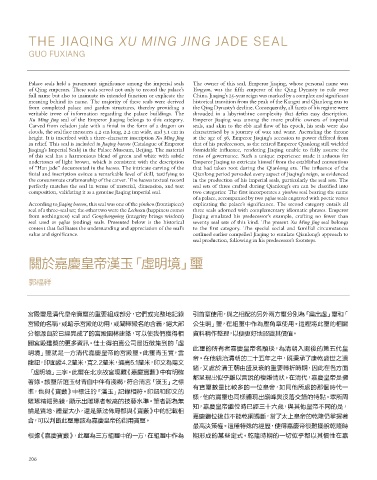Page 208 - Christie's Important Chinese Works of Art, May 31 to June 1, 2023 Hong Kong
P. 208
THE JIAQING XU MING JING JADE SEAL
GUO FUXIANG
Palace seals held a paramount significance among the imperial seals The owner of this seal, Emperor Jiaqing, whose personal name was
of Qing emperors. These seals served not only to record the palace’s Yongyan, was the fifth emperor of the Qing Dynasty to rule over
full name but also to insinuate its intended function or explicate the China. Jiaqing’s 25-year reign was marked by a complex and significant
meaning behind its name. The majority of these seals were derived historical transition from the peak of the Kangxi and Qianlong eras to
from completed palace and garden structures, thereby providing a the Qing Dynasty’s decline. Consequently, all facets of his regime were
veritable trove of information regarding the palace buildings. The shrouded in a labyrinthine complexity that defies easy description.
Xu Ming Jing seal of the Emperor Jiaqing belongs to this category. Emperor Jiaqing was among the more prolific owners of imperial
Carved from celadon jade with a finial in the form of a dragon on seals, and akin to the ebb and flow of his epoch, his seals were also
clouds, the seal face measures 4.2 cm long, 2.2 cm wide, and 5.1 cm in characterised by a journey of wax and wane. Ascending the throne
height. It is inscribed with a three-character inscription Xu Ming Jing at the age of 36, Emperor Jiaqing’s accession to power differed from
in relief. This seal is included in Jiaqing baosou (Catalogue of Emperor that of his predecessors, as the retired Emperor Qianlong still wielded
Jiaqing’s Imperial Seals) in the Palace Museum, Beijing. The material formidable influence, rendering Jiaqing unable to fully assume the
of this seal has a harmonious blend of green and white with subtle reins of governance. Such a unique experience made it arduous for
undertones of light brown, which is consistent with the description Emperor Jiaqing to extricate himself from the established conventions
of “Han jade” documented in the baosou. The intricate carving of the that had taken root during the Qianlong era. The influence of the
finial and inscription evince a remarkable level of skill, testifying to Qianlong period pervaded every aspect of Jiaqing’s reign, as evidenced
the consummate craftsmanship of the carver. The baosou textual record in the production of his imperial seals, particularly the seal sets. The
perfectly matches the seal in terms of material, dimension, and text seal sets of three crafted during Qianlong’s era can be classified into
composition, validating it as a genuine Jiaqing imperial seal. two categories: The first incorporates a yinshou seal bearing the name
of a palace, accompanied by two yajiao seals engraved with poetic verses
According to Jiaqing baosou, this seal was one of the yinshou (frontispiece) explicating the palace’s significance. The second category entails all
seal of a three-seal set; the other two were the Lechuxu (happiness comes three seals adorned with complementary idiomatic phrases. Emperor
from nothingness) seal and Gongshengming (integrity brings wisdom) Jiaqing emulated his predecessor’s example, crafting no fewer than
seal used as yajiao (ending) seals. Presented below is the historical seventy seal sets of this kind. The present Xu Ming Jing seal belongs
context that facilitates the understanding and appreciation of the seal’s to the first category. The special social and familial circumstances
value and significance. outlined earlier compelled Jiaqing to emulate Qianlong’s approach to
seal production, following in his predecessor’s footsteps.
關於嘉慶皇帝漢玉「虛明境」璽
郭福祥
宮殿璽是清代皇帝寶璽的重要組成部分,它們或完整地記錄 引首章使用,與之相配的另外兩方璽分別為「樂出虛」璽和「
宮殿的名稱,或暗示宮殿的功用,或闡釋殿名的含義,絕大部 公生明」璽,在組璽中作為壓角章使用。這裡將此璽的相關
分都源自於已經完成了的宮殿園林建築,可以使我們獲得相 資料稍作整理,以便更好地認識其價值。
關宮殿建築的更多資訊。佳士得拍賣公司最近徵集到的「虛
此璽的所有者嘉慶皇帝名顒琰,為清朝入關後的第五代皇
明境」璽就是一方清代嘉慶皇帝的宮殿璽。此璽青玉質,雲
帝。在他統治清朝的二十五年之中,既秉承了康乾盛世之遺
龍鈕,印面縱4.2釐米,寬2.2釐米,通高5.1釐米,印文為陽文
緒,又處於清王朝由盛及衰的重要轉折時期,因此在各方面
「虛明境」三字。此璽在北京故宮現藏《嘉慶寶藪》中有明確
都呈現出似乎難以言說的複雜情狀。在清代,嘉慶皇帝是擁
著錄。該璽所選玉材青白中伴有淺褐,符合清宮「漢玉」之標
有寶璽數量比較多的一位皇帝,如同他所處的那個時代一
準,也與《寶藪》中標注的「漢玉」記錄相符。印鈕和印文的
樣,他的寶璽也同樣體現出巔峰與沒落交錯的特點。眾所周
雕琢精細熟練,顯示出雕琢者較高的技藝水準。筆者認為無
知,嘉慶皇帝繼位時已經三十六歲,與其他皇帝不同的是,
論是質地、體量大小,還是篆法佈局都與《寶藪》中的記載相
嘉慶繼位後並不能乾綱獨斷,當了太上皇帝的乾隆仍掌握著
合,可以判斷此璽應該為嘉慶皇帝的御用寶璽。
最高決策權。這種特殊的經歷,使得嘉慶帝很難擺脫乾隆時
根據《嘉慶寶藪》,此璽為三方組璽中的一方,在組璽中作為 期形成的某些定式。乾隆時期的一切似乎都以其慣性在嘉
206

